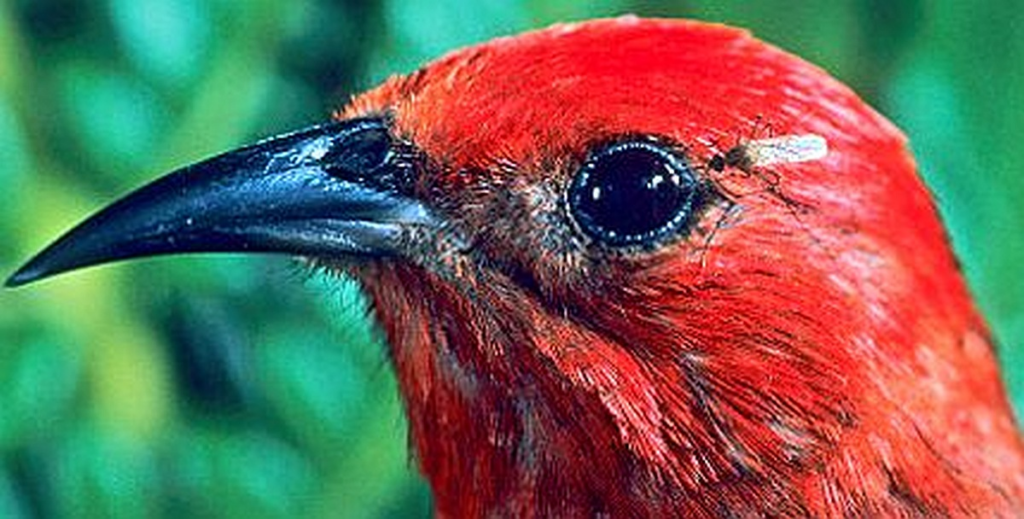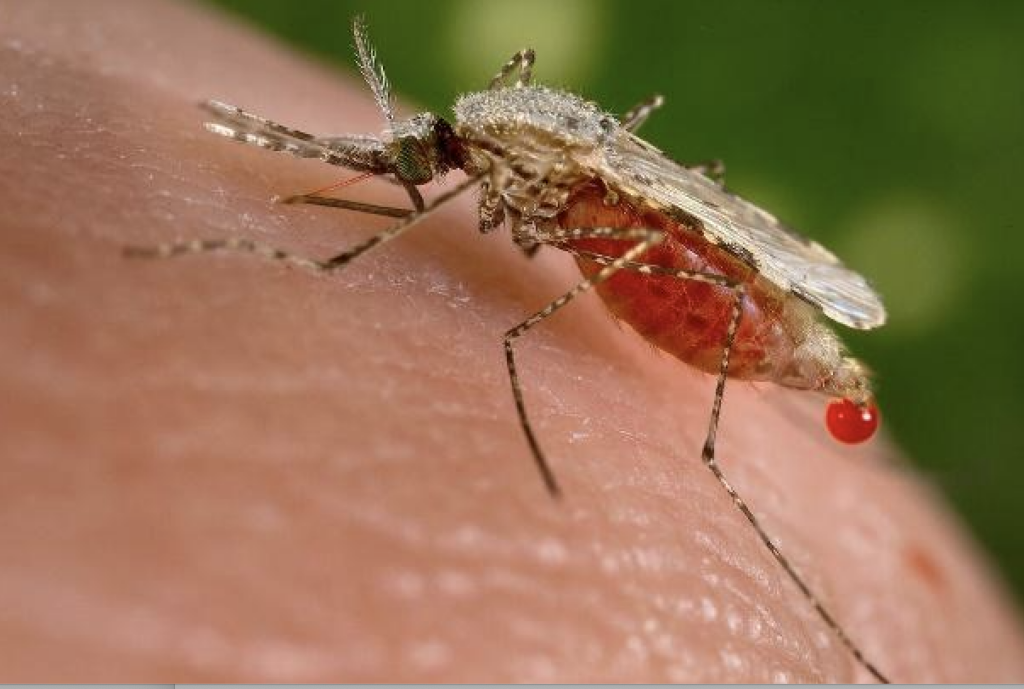The Impact of Global Warming on Human and Avian Malaria
By Oswaldo Villena, Postdoctoral Researcher at The Earth Commons

Apapane (Himatione sanguinea), a crimson red Hawaiian honeycreeper, being bitten by an invasive mosquito Cx. quinquefasciatus. Photo by Jack Jeffrey.
As a result of increased atmospheric greenhouse gases, especially carbon dioxide and methane, the global surface temperature has been increasing over the last century — and that increase has been exponential in recent decades.
The atmospheric concentration of CO2 was 280 parts per million (ppm) in preindustrial times, whereas it is almost 420 ppm today. Levels are even predicted to further increase to as high as 1,000 ppm by the end of the century under the Representative Concentration Pathway 8.5 (RCP 8.5) scenario.
With many climate simulations projecting a warmer future, the distribution of ectothermic vectors, such as mosquitoes, are expected to change in response to global warming, affecting vector-borne disease transmission.
Here I will discuss two emblematic cases: human malaria in Africa and avian malaria in Hawaii.
Invasive mosquitoes on the rise in Africa show a greater thermal range of transmission.
Malaria is the deadliest vector-borne disease worldwide.
In 2021 alone, the World Health Organization (WHO) reported 247 million malaria cases worldwide. Of the total malaria cases, an estimated 619,000 resulted in death, with 94.7% of cases and 95.8 % of the deaths occurring on the African continent. Furthermore, after a steady decline in cases from 2000 to 2015, there has been a resurgence of malaria transmission in many parts of Africa because mosquitoes have become more resistant to the insecticides used on bed nets.
Malaria is caused by protozoan parasites of the genus Plasmodium, which are transmitted by mosquitoes of the genus Anopheles. Anopheles gambiae, a mosquito adapted to rural areas, is the main malaria vector in Africa.
However, in the last decade, the Asian malaria mosquito, Anopheles stephensi, native to South Asia and the Middle East, has been invading Africa. Detections of An. stephensi have been reported in Djibouti beginning in 2012, Ethiopia and Sudan since 2016, Somalia in 2019, Nigeria as early as 2020 and Kenya from 2022 onward. It is also likely that this mosquito is already present in other African countries, but its low population counts and/or the lack of a structured surveillance system have prevented its detection.
An. stephensi is a vector of both the Plasmodium falciparum and the Plasmodium vivax malaria parasites. Moreover, this mosquito poses a novel and unique challenge to vector control in Africa because An. stephensi are very well adapted to urban areas and prefer human-made water storage containers in contrast to An. gambiae. This allows the An. stephensi species to survive year-round and to stay active during the dry seasons.
A 2022 study by Villena et al. found that the optimum temperature for the transmission of P. falciparum and P. vivax parasites by An. stephensi and An. gambiae mosquitoes is very similar — about 25 degrees Celsius. However, the thermal limits of each malaria vector represent the primary differences in transmission capacity.
For An. stephensi, the temperature range of transmission for P. falciparum is between 15.3 and 37.2 degrees Celsius; the temperature range of transmission for P. vivax the temperature range is between 15.7 and 32.5 degrees Celsius.
In contrast, for An. gambiae, the temperature ranges for the transmission of P. falciparum and P. vivax are from 19.1 to 30.1 degrees Celsius and 19.2 to 31.7 degrees Celsius, respectively.
Thus, An. stephensi mosquitoes can transmit malaria over a greater temperature range, posing a greater risk. Given the larger thermal breadth, malaria could spread to countries with greater temperature ranges where the disease is not typically endemic.
A recent study by Ryan et al. (2023) projected that by 2050, most of Africa would be suitable for nearly year-round malaria transmission. This is especially true for the P. falciparum parasite, the most virulent form of malaria, for which transmission suitability extends further north and south than P. vivax (See figure 3).
In addition, that research estimated that the number of people at risk (PAR) for year-round transmission suitability of P. falciparum by An. stephensi in 2050 under the greenhouse scenario RCP 4.5 will be over 600 million people. And RCP 4.5 is a relatively moderate scenario in which greenhouse emissions peak around 2040 before declining.
For population projection, Ryan et al. used the shared socioeconomic pathway 2 (SSP2) — which represents a “middle of the road” scenario — to assume that patterns of social, economic and technological growth will not appreciably deviate from historical trends. For the P. vivax parasite transmitted via An. stephensi mosquitoes — under the same scenarios — just under 300 million people will be at risk of contracting malaria by 2050.

Anopheles stephensi mosquito on skin.- Photo (#5814) by Jim Gathany for the Center for Diseases Control and Prevention public health image library.
In summary, the presence of An. stephensi mosquitoes in Africa poses a great risk in the battle against malaria because the invasive species is well adapted to urban settings and has a greater thermal range of transmission in comparison to native mosquitoes. The two studies mentioned serve as a call for surveillance and preemptive interventions, planning, monitoring and control against An. stephensi.
Avian malaria and the honeycreeper crisis in Hawaii
Hawaiian honeycreepers, a group of endemic Hawaiian forest birds, evolved in isolation over millions of years, one of the more impressive cases of adaptive radiation the ornithological world has ever seen.
Native honeycreepers evolved in the absence of many of the threats now present in Hawaii, including avian malaria — a non-native disease that is driving honeycreeper populations toward extinction. Avian malaria is caused by the invasive parasite Plasmodium relictum, which is transmitted by the invasive mosquito Culex quinquefasciatus.
The P. relictum parasites reached Hawaii via exotic birds brought by settlers in the early 1800s. And C. quinquefasciatus mosquitoes arrived around 1826 when whaling ship soldiers drained their water barrels off the coast of the island. The first detected case of avian malaria in Hawaii goes back to 1940.
At one point, there were 70 honeycreeper species; today, that number has dropped to 17, 14 of which are already listed as endangered. Avian malaria has been the leading factor for extinction of these species.
Through their influence on the distribution and abundance of mosquitoes, environmental factors, especially temperature and precipitation, play an important role in shaping the dynamics of mosquito-borne disease transmission.
Transmission of avian malaria in Hawaii varies across altitudinal gradients and is greatest at elevations below 1,500 meters (m) where temperature is favorable for the vector, C. quinquefasciatus and the development of the parasite. For a number of years, honeycreepers found refuge at high elevations (greater than 1500m), where cooler temperatures did not allow the development of the mosquito or the malaria-inducing parasite.
However, the relief was short-lived due to global warming. Warmer temperatures make the development of mosquitoes at high elevations possible.
For example, the seasonality of vector in-situ development suitability (VIDS) — particularly the onset and cessation of suitable conditions throughout the year — has increased in recent years. On the island of Kauai, the high elevation areas, situated between 1,350m and 1,450m above sea level, exhibited the most significant shifts, experiencing the onset of VIDS more than 8 days earlier each year.
On the Big Island, changes were also observed, albeit more moderate. The elevational band of 1,550m to 1,650m recorded an advancement in VIDS onset by more than 7 days annually. Furthermore, Maui’s elevational range of 1,500m to 1,700m showed a progression in the onset of VIDS by roughly 4.5 to 6 days per year.
This increase in the onset of VIDS on each island suggests an extended period of mosquito-friendly conditions both early and late in each calendar year.
In 2016, a group of mosquito experts, public health professionals, wildlife specialists and local leaders convened to discuss novel technologies to transform, suppress and ideally eliminate alien mosquitoes from the Hawaiian Islands through an integrative system thinking approach.
One plan calls for the production and release of sterile mosquitoes to decimate the wild mosquito population. This strategy would require an estimation of the quantities and location of mosquitoes in the wild.
Data on mosquito occurrence and abundance estimates could help to direct the release of sterile mosquitoes to reduce C. quenquifasciatus in Hawaii, thus helping to prevent the extinction of the remaining honeycreepers.
